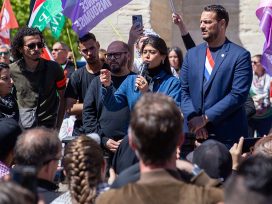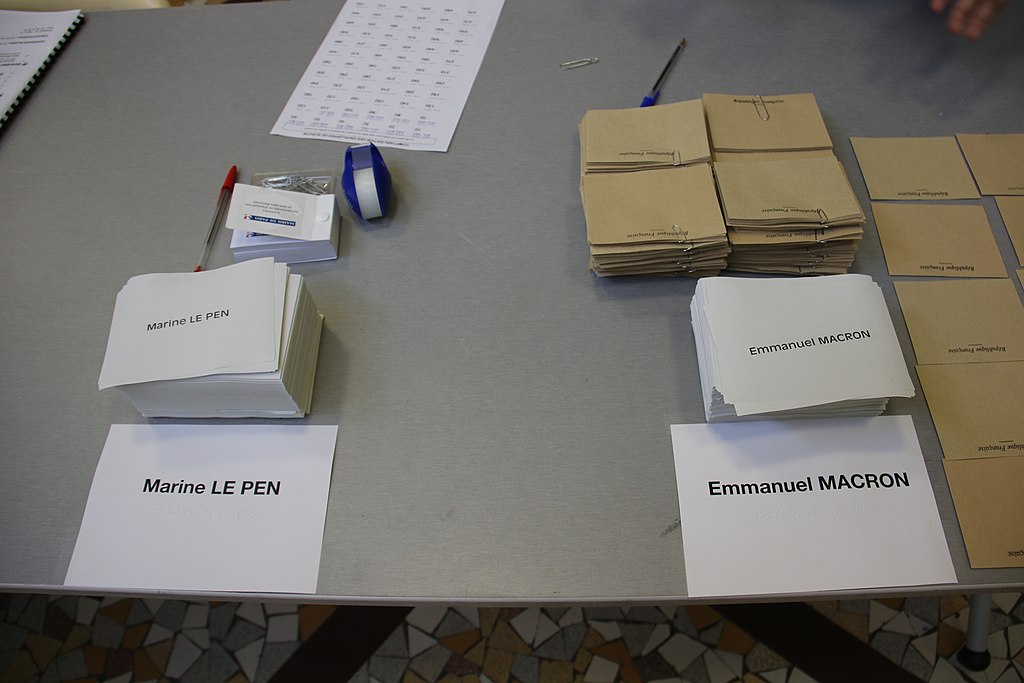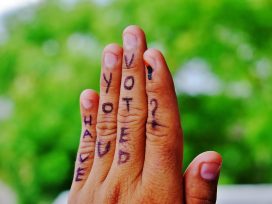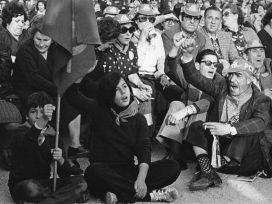When France’s constitutional council published its list of approved candidates on 7 March, the campaign for the presidential election, to be held over two rounds on 10 and 24 April, may be said to have been officially launched. The candidates and their affiliations are as follows: Emmanuel Macron (centrist, La République en Marche); Marine Le Pen (far right, Rassemblement National); Eric Zemmour (far right, Reconquête); Jean-Luc Mélenchon (radical left, La France Insoumise); Valérie Pécresse (centre right, Les Républicains); Yannick Jadot (Green, Europe Écologie Les Verts); Fabien Roussel (communist, Parti Communiste); Anne Hidalgo (centre left, Parti Socialiste); Jean Lassalle (Eurosceptic centrist, Résistons); Nicolas Dupont-Aignan (right-wing sovereigntist, Debout La France); Philippe Poutou (Trotskyist revolutionary left, Nouveau Parti Anticapitaliste); Nathalie Arthaud (Trotskyist revolutionary left, Lutte Ouvrière).
In the two-stage process of the election, the most important question is which two candidates, of these twelve, will make it to the run-off on 24 April. But there is also considerable interest in how things will shake out for some of the other challengers. First let us dispense with a few of the also-rans. In the 2017 election, in which Jean Lassalle, Philippe Poutou and Nathalie Arthaud also stood, they garnered 1.21%, 1.09% and 0.64% of the first-round vote respectively. Nicolas Dupont-Aignan secured 4.7%. Opinion polling this time around suggests that the first three will perform at about the same level as in 2017 but that Dupont-Aignan’s vote will, in what has become a highly contested field on the right and far right, collapse.
That leaves eight candidates: on the left Roussel, Mélenchon, Hidalgo and Jadot (in France the Greens are on the left), in the centre Macron, and on the right Pécresse, Le Pen and Zemmour.

Le Pen and Macron, French election posters. Image by Lorie Shaull via Flickr.
Let us dig a little deeper, starting with the right. Elected in 2017, Emmanuel Macron was in many ways an accidental president, the accident being the unexpected collapse in the polls of the centre-right candidate and till then favourite, François Fillon, caught out in a relatively minor piece of corruption involving paying his wife with state funds for a fictitious employment. In late 2016 some opinion polls were formulated on the basis that Alain Juppé, a popular long-time mayor of Bordeaux, might be endorsed as the centre-right candidate. These showed him performing strongly, but in the end he was not chosen by his party to run, being perhaps perceived as too moderate (particularly on immigration) by many members.
Around this time Macron was also first mooted as a candidate but as a possible standard-bearer for the Parti Socialiste. Again, he performed well in polling but soon made it clear that he would not be a PS candidate but would form his own party. Towards the end of 2016 and early in 2017 the polls had settled into a pattern showing Le Pen slightly ahead, followed closely by Fillon and then, in third place and initially a good deal behind, Macron. Fillon’s political collapse, starting in January 2017, facilitated a Macron surge, which in late polling eventually saw him passing out both the centre right and the far right, predictions that were confirmed by the first-round result on 23 April (Macron 24.01%, Le Pen 21.3%, Fillon 20.01% and Mélenchon, for the left, 19.58%). In the current state of play of French politics, in any contest between the extreme right and someone else, there is likely to be only one winner. And so, in the second round of voting on 7 May, Macron beat Le Pen by 66.1% to 33.9%.
The 2022 presidential campaign has featured some of the same players as 2017 and some new ones, of which by far the most important for the way the contest has shaped up has been Eric Zemmour, a challenger to Marine Le Pen on the far right. Zemmour, an exotic ‘popular historian’ and polemical broadcaster on the further shores of French nationalism, entered the fray last, after much highly publicized hesitation on 30 November, and almost immediately seemed to put Marine Le Pen in difficulty, polling at around the same level as the RN leader and threatening her with possible exclusion from the second round through a 50-50 division of the far-right vote which would benefit the centre right’s Valérie Pécresse.
Le Pen and Zemmour, who share up to 30% of voting intentions between them, represent fairly distinct far-right visions. While both are very strongly nationalist, anti-immigration and broadly Eurosceptic, Zemmour appeals to a section of the traditional Catholic right (though he is himself Jewish) that Le Pen appears to have turned her back on. Sociologically, while a high proportion of Le Pen’s supporters are blue-collar workers, there are likely to be quite a few prosperous people among Zemmour’s voters, who are not particularly keen on being taxed to pay for social welfare. Zemmour’s hostility to Muslims is more strongly and uncompromisingly expressed than Le Pen’s to immigrants; he is also loudly contemptuous of feminists and of the LGBT+ movement. Both far-right candidates agree in seeing France as being done down by liberal-cosmopolitan elites and globalism.
In the last month of the campaign, the opinion polls showed signs of settling down: Macron enjoying a commanding lead, followed by Le Pen, then Pécresse, then Zemmour. The then five-point gap between Le Pen and Pécresse proved difficult to bridge over a matter of weeks. Zemmour has faded in response to questions about his political judgment, in particular his wild enthusiasm for Vladimir Putin. (Three other candidates – Le Pen, Mélenchon and Rousset – have also tended to be very understanding of ‘Russian security interests’ but they have condemned the invasion of Ukraine and do not seem to have been severely penalized for their previous positions.)
Why is the centre right, once such a strong force (the strongest) in French politics, again failing to make an impact. The chief problem is of course the huge presence of the far right. This forces the traditional right, currently grouped together in Les Républicains, a party in the Gaullist tradition, to make a choice: will it veer towards the centre or towards the right? In 2017 and again in 2021/22 it has chosen the latter course. There is nothing easy about the situation Les Républicains find themselves in: on one side they have to compete with Macron, on the other with Le Pen and Zemmour. Valérie Pécresse’s campaign got off to a flying start, but has since stalled rather badly. She was not the first choice of her party.
Opinion polling throughout 2021 consistently showed that Xavier Bertrand, president of the Hauts-de-France region in the north, was the man most likely to succeed for LR, that is the potential candidate most favoured by voters. But again, being too much of a centrist, he failed to win the support of his party. In the first round of voting in LR’s primary the winner was Eric Ciotti, the most right-wing candidate on offer (in fact a close political friend of Eric Zemmour). In the run-off against Ciotti, Pécresse garnered the support of the eliminated contenders (including Michel Barnier) but seems to have been forced by the party to take on board a number of Ciotti’s political perspectives. Given that such hardline stances will always tend to be given more forceful and unambiguous expression by Le Pen and Zemmour, this is scarcely a winning strategy for the centre right.
Moving to the left, one could say that the conduct of the campaign so far has been something of a farce, though without the laughs. Again, the rot set in some time ago, probably during the presidency of François Hollande, when the Socialist Party (PS) lost the ability, or the will, to bring together (fédérer is the favoured French word) the various political currents inside and outside the party in the interests of presenting a credible candidature on the left (that is, one with a chance of winning) in the presidential race.
A primary in the PS (also taking in closely allied organizations) chose the left-winger Benoît Hamon to be the party’s presidential candidate, but soon two of the defeated candidates, who had garnered about a third of the 1.6 million votes cast between them, announced that they would be voting for Emmanuel Macron (breaking promises they had made to accept the result). Hamon struggled to differentiate his left-wing message from that of Jean-Luc Mélenchon, who was also backed by the Communist Party. The PS candidate won 6.36% of the vote to France Insoumise’s 19.58%.
It was probably at this point that a significant number of the PS’s social democratic wing decided that there was no future for them in the party. For this they were of course roundly denounced as traitors by the party leadership, but it may be only fair to say that it is not just rats who decide that a sinking ship is not a place in which to linger.
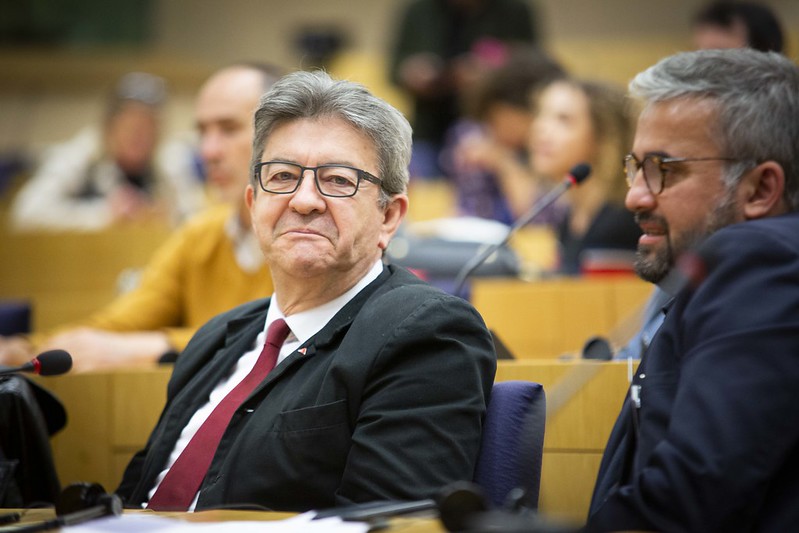
Jean-Luc Mélenchon. Photo by The Left EU from Flickr
In this year’s election the Communist Party is running its own candidate. For this and quite possibly other reasons Mélenchon may not score much more than half of his 2017 percentage. In the last presidential election, the Greens (EELV) backed the socialist – who even with this support, as we have seen, polled abysmally. This time they are running their own candidate, Jadot, who is consistently polling marginally ahead of socialist Hidalgo.
The scintillating French television drama Baron Noir (Canal+, three seasons, 2016-20) featured as its main character the socialist ‘baron’ Philippe Rickwaert, a PS politician of immense conviction and intelligence (but very flexible morality) whose driving passion was to win political power by forging unity between the various components of the Left. In this fight he faced many obstacles, none more formidable than the stubbornness of the radical Michel Vidal, a very thinly disguised representation of Jean-Luc Mélenchon. A less inspiring attempt to unite the Left occurred in real life between October 2020 and January 2022 under the auspices of a ‘citizens’ initiative’ called the People’s Primary.
This attempt to designate a single left unity candidate apparently attracted funding of €730,000, the participation of 467,000 voters (this figure cannot be verified) and the support of such luminaries as Juliette Binoche. What it did not attract was the support of any of the major left-wing candidates. And so – without such support – its findings were deemed irrelevant and its procedures boycotted by anyone who mattered. Whatever one’s opinion of Jean-Luc Mélenchon, for example, he would surely be justified in being reluctant to stand aside if the verdict of this phantom half-million was not favourable to him when he had won the support of more than seven million real citizens in the 2017 election.
In summary, one might say that if the French Left has not been united – and will not be united any time soon – it has been reconfigured. Up until the 1970s and the advent of the political project of François Mitterrand, the communist party was often the largest force on the Left. Mitterrand changed that, not by crushing his rivals but by devising an ambitious common programme for government in which he encouraged them to join with him. Mitterrand’s party was recently polling at two or three percent, while its rivals to the Left (France Insoumise and the communists) commanded fifteen percent. It is certainly a victory of some kind – a victory over the socialists – but in Mitterrand’s second presidential success in 1988, won after seven tough years in office, socialists and communists together (but excluding Trotskyists) polled 43% of the national vote in the first round.
A support level of 15% certainly suggests that there is still a good measure of support in France for what many might call ‘real socialist policies’. Indeed policy seems to be what motivates most FI voters rather than any particular admiration for Mélenchon himself: see ‘Election présidentielle 2022 : forces et faiblesses de la dynamique Mélenchon’, based on a Le Monde survey, published 5 March. (Curiously, almost the opposite is the case with Macron: voters are more reassured by the man than by his political vision – perhaps they are not sure what it is.)
Mélenchon, who has long had about him more than a touch of le socialisme, c’est moi, may be satisfied with proving that FI still exists, while the PS, in whose ranks he was a militant for thirty-two years, seems to be well along the road to disappearance. But where is it all going? French socialism has long been characterized by a very high degree of both personal rivalry and doctrinal dispute: the vanity and egoism of many of the main players sometimes seem to reach stratospheric levels. The Left electoral project traditionally relied on the coming together of diverse elements (courants), each of which might, in government, be given the chance to have aspects of its policies translated into action.
In Britain, before the sharpening of ideological conflict brought about by Blairism and Corbynism, this type of capacious movement in which there was certainly internal conflict yet also a significant measure of mutual tolerance, was usually referred to as ‘a broad church’. One would have to ask now where the French Left thinks it is going. Fifteen percent is not nothing, but without the social democratic vote, which has migrated to Macron, what exactly is the point of the project? Unless of course the purpose of politics is simply … to be political.
Two opinion polls published in early March showed the French political landscape divided into four major groups, with a fairly substantial radical left with about 15% support, a much diminished centre-left (PS and Greens) with about 8%, a solid centre, on 30%, and a very large but divided right on 45% or 46%. This seems very likely to lead to a further presidential term for Emmanuel Macron, who will again face Marine Le Pen and again defeat her, but very probably, given the overall strength of right-wing sentiment in France, by a smaller margin than in 2017.
In the longer term, the question will be can the centre, a recent alliance – or cobbling together if you like – of elements drawn from the centre-right and centre-left camps, hold together in the post-Macron era? That may depend on the quality of the personnel available in 2027, as well as on the performance of the second Macron presidency.
For the traditional right, some soul-searching will be in order. In two successive elections Les Républicains have attempted to counter the challenge of the radical right by themselves moving significantly towards more hardline positions on a range of issues. On neither occasion has this strategy worked. The existence of a politically competent bloc in the centre (something France has not seen for a number of generations) seems to be standing in the way of a future for the inheritors of the Gaullist tradition.
For the centre-left, the outlook seems even worse. If the Parti Socialiste candidate polls only two or three percent it must surely be time to consider winding up the party, or at least considering creating an entirely new formation fusing the socialists and Greens: the two parties are already very compatible in policy. Whether such a project could give new impetus to the inheritors of a currently seriously depressed political tradition is an open question. One thing is certain: the country that ‘invented the Left’ and which is still associated in many people’s minds with the spirit of lively resistance to power, is today looking in a quite different direction.
In the above article, first published on 8 March, I wrote that the candidates of the far right, Le Pen and Zemmour ‘share up to 30% of voting intentions between them’. In the final week of polling that is now looking more like 31% or 32%: the increase comes from Le Pen’s figures, not Zemmour’s. Emmanuel Macron’s percentage hit a high of 30% or 31% during the first half of March but has now fallen back a few points while Le Pen’s has risen to 22% or 23%. The gap between the leading and the second candidate could now be as narrow as a few points.
In the course of the month, Jean-Luc Mélenchon appears to have made significant progress, moving very comfortably into third place, yet still well behind Le Pen. If at the beginning of March the combined support of La France Insoumise and the Communists (‘the radical left’) seemed to stand at about 15%, the forecast would now be more like 17% or 18%. Two candidates who earlier in the campaign had appeared to mount a substantial challenge but were fading by early March, Pécresse on the centre right and Zemmour on the far right, have not arrested their decline and are no longer significant players. The low scores for the marginal candidates and for Hidalgo (socialist) and Jadot (Green) have not significantly moved.
This article was first published by Dublin Review of Books.
